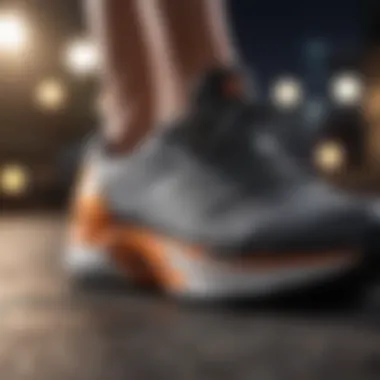Discover the Best Comfortable Walking Sneakers


Intro
Walking sneakers are not just a trend; they play a vital role in our daily mobility and foot health. Choosing the right pair can significantly influence comfort, support, and overall well-being. This article seeks to outline the various aspects that make walking sneakers comfortable. From the design elements to specific technologies used, we will cover everything that ensures a pleasant walking experience.
In addition, we will explore well-known brands that have made a name for themselves in the footwear industry due to their commitment to comfort. We will discuss how individuals can assess their specific needs and preferences when selecting the best walking sneakers. By emphasizing foot health, support mechanisms, and proper maintenance, readers will gain a comprehensive understanding of why the right footwear matters. The goal is to provide not just suggestions but also practical advice on how to keep sneakers in optimal condition. Ultimately, investing in a good pair of walking sneakers can have far-reaching impacts on overall well-being and enjoyment in daily activities.
Understanding Comfort in Walking Sneakers
Walking sneakers are designed with specific elements that prioritize comfort. Understanding the importance of comfort in these shoes is essential for maintaining foot health and enhancing the walking experience. The complex dynamics of how our feet interact with the ground play a vital role in overall well-being. Inadequate footwear can lead to various issues such as foot pain, joint discomfort, and even long-term injuries.
The Role of Support
Support is one of the foundational aspects of a comfortable walking sneaker. Proper support helps to distribute weight evenly across the foot, preventing excessive strain on any single area. Walking sneakers should provide support for the arches, as this can significantly impact posture. Insufficient arch support often leads to unhealthy gait patterns. This can eventually cause discomfort and pain in the feet, knees, and lower back.
It's essential to consider the overall structure of a sneaker. Models with a firm heel counter and adequate midsole are crucial for maintaining stability during movement. High-quality insoles can enhance this support further, adapting to an individual's foot shape and walking style.
Cushioning Mechanisms
Cushioning mechanisms are essential for absorbing impact during walking. Various technologies and materials are employed to provide this cushioning effect. Memory foam and gel inserts are commonly used for their ability to conform to the shape of the foot. These cushioning materials enhance comfort by reducing shock, minimizing tiredness during extended periods of activity.
When selecting walking sneakers, it is vital to assess the cushioning level. Some people may require more cushioning for long-distance walks, whereas others might prefer a firmer feel for better ground connection. Also, not all cushioning systems are created equal, and individuals should explore different options to discover what works best for them.
Breathability and Material
Breathability in walking sneakers plays a significant role in comfort. The materials used in the upper part of the sneaker often determine how well air circulates around the foot. Sneakers made with mesh fabric promote airflow and help keep the feet dry. This is particularly beneficial during warm weather or extended walks, significantly reducing the chances of blisters and other skin irritations.
The choice of materials also affects durability and overall feel. Natural materials like leather can offer a great fit but might lack some breathability compared to synthetic options. Therefore, striking a balance between comfort, breathability, and material durability is essential when selecting an appropriate walking sneaker.
"In choosing the right walking sneakers, evaluating comfort features like support, cushioning, and breathability can foster a more enjoyable walking experience and support overall foot health."
Understanding these aspects of comfort equips individuals with the knowledge to make informed choices, ensuring that they select walking sneakers that meet their unique needs.
Key Features of Comfortable Walking Sneakers
Understanding key features of comfortable walking sneakers is crucial for making informed decisions. This section will explore specific elements that contribute to overall comfort, performance, and support. By considering these components, consumers can choose sneakers that align with their personal needs and preferences for walking.
Insole Technology
Insole technology plays a significant role in ensuring comfort during walks. Many walking sneakers employ varied insole materials and designs to enhance cushioning and support.
- Memory foam: This material conforms to the foot's shape, providing personalized support and reducing pressure points.
- Gel inserts: Commonly used in brands like ASICS, gel provides excellent shock absorption, which is essential for long walks.
- Arch support: Some insoles come with built-in arch support, vital for maintaining foot health, particularly for people with flat feet or high arches.
Investing in sneakers with advanced insole technology can make a noticeable difference in comfort over extended periods.
Sole Design and Structure
The sole design and structure are equally important in walking sneakers. A well-constructed sole contributes to stability, traction, and comfort during each step.
- Flexibility: Sneakers with flexible soles allow for natural foot movement. This reduces strain during walking.
- Tread patterns: A good tread design enhances grip on various surfaces. This is important for safety and can affect walking efficiency.
- Heel-to-toe drop: This refers to the height difference between the heel and the toe. A lower drop promotes a more natural running and walking style, which can prevent injuries and improve comfort.
Weight Considerations
The weight of walking sneakers is a critical factor in their overall comfort. Lighter sneakers contribute to a less fatigue during prolonged use.
- Material choice: Technologies such as lightweight foam and mesh upper contribute to reduced weight. Brands like Nike and Brooks focus on using these materials to enhance user experience.
- Support without bulk: It is essential to balance lightweight design with necessary support. Sneakers that are lightweight but do not skimp on cushioning and stability provide the best comfort.
Key Takeaway: When selecting walking sneakers, consider insole technology, sole design, and weight to ensure maximum comfort and support.
Material Composition in Sneaker Comfort


Understanding the composition of materials used in walking sneakers is crucial for anyone serious about comfort and foot health. The right materials can make a significant difference in how a sneaker feels during use. Each material brings its own set of benefits and drawbacks, affecting not just comfort but also durability and functionality. This article section examines synthetic and natural materials, their durability, and the importance of water resistance features in walking sneakers.
Synthetic vs. Natural Materials
The debate between synthetic and natural materials in sneaker construction often centers around comfort, weight, and longevity.
Synthetic materials, like polyester or nylon, tend to be lightweight and more affordable. They also have better moisture-wicking properties, making them ideal for prolonged wear. Sneakers made from synthetic materials often feature mesh panels which enhance breathability. However, some may find that synthetic materials lack the soft touch of natural counterparts and can lead to discomfort in the long run.
On the other hand, natural materials such as leather or cotton can provide excellent fit and comfort. Leather conforms to the shape of the foot over time, often resulting in a custom-like fit. Yet, natural materials can be heavier and may require more maintenance to keep them in good condition. It is important to consider personal preferences when making a choice between these materials.
Durability of Different Materials
Durability in walking sneakers is a multi-faceted topic. Sneaker longevity highly depends on the materials used.
- Rubber is frequently employed in the outsole. It provides traction and absorbs shock well. High-quality rubber can withstand wear and tear from various terrains.
- EVA foam, commonly used in midsoles, is lightweight and offers a good balance between cushioning and stability. However, it can compress over time.
- Mesh uppers often used for breathability may tear easily if exposed to rigorous conditions.
Thus, an aware consumer must assess how often and in what conditions they plan to use their sneakers.
Water Resistance Features
Water resistance is another vital factor to consider when evaluating sneaker comfort. Wet conditions can lead to blisters and discomfort.
Some brands utilize waterproof materials to prevent moisture intrusion. This often includes features like:
- Gore-Tex membranes, which allow sweat to escape while keeping water out.
- DWR (Durable Water Repellent) coatings applied to synthetic fabrics.
These features can significantly enhance the comfort level, especially in climates that are humid or rainy. A sneaker that fights off water can keep feet dry, which is essential for foot health during long walks or hikes.
Maintaining awareness of material composition gives a significant advantage in selecting a walking sneaker that aligns best with individual needs and preferences.
Popular Brands for Comfortable Walking Sneakers
In the realm of walking sneakers, brand reputation often intertwines with comfort and innovation. Choosing well-known brands can significantly enhance your walking experience. Each brand focuses on specific areas such as cushioning, support, and design. This is important for both casual walkers and those seeking fitness benefits through walking. Moreover, popular brands frequently invest in research, keeping their products at the forefront of technology.
These brands frequently have established their name due to consistent quality and performance. Evaluating comfort features, materials used, and consumer feedback is essential for making informed choices.
ASICS: A Legacy in Comfort
ASICS has carved its niche as a leader in athletic footwear. Its emphasis on biomechanics sets it apart. The Gel cushioning system absorbs shock, making every step smoother. This technology assists in reducing stress on joints. Furthermore, the brand focuses on creating sneakers that fit well with various foot shapes. The emphasis on arch support ensures that users experience both comfort and stability.
New Balance: Merging Style with Function
New Balance is famed for its blend of style and performance. It caters well to individuals seeking sneakers for both exercise and everyday wear. The brand offers a wide range of options, often focusing on custom fit. This is especially helpful for individuals with wider feet.
Additionally, New Balance sneakers frequently feature fresh foam cushioning, promoting comfort over long distances. This cushioning type adapts to foot movements, offering a personalized feel. Thus, it provides both support and nice aesthetics.
Nike: Innovative Comfort Technologies
Nike continuously pushes boundaries in footwear technology. The brand invests heavily in research, resulting in innovative products. For example, the use of Flyknit material ensures breathability and flexibility. This lightweight nature aids in reducing fatigue over longer walks.
Moreover, Nike sneakers often include Zoom Air technology, providing responsive cushioning. This enhances comfort during activities requiring sudden movements. Consequently, Nike transcends traditional walker needs, appealing to active lifestyles.
Innovation plays a critical role in comfort. Brands like Nike illustrate this by merging advanced materials with user-friendly designs.
Brooks: Focus on Foot Health
Brooks specializes in foot health, making it a prime contender in the comfort sneaker market. The company's designs prioritize the health of the feet from the ground up. With features like DNA loft cushioning, Brooks ensures that each step is soft yet responsive.
The brand also incorporates last technology, which creates shoes that mimic the shape of the foot. This focus on foot shape ensures proper alignment and support. Additionally, Brooks frequently collaborates with podiatrists to optimize shoe design for health benefits. Overall, this dedication to foot health makes Brooks a wise choice for anyone serious about comfort.
In summary, exploring popular brands sheds light on critical features of comfortable walking sneakers. Each brand boasts its unique strengths, from technological innovation to focus on foot health. This understanding assists in selecting the right footwear based on personal needs.


Assessing Fit and Sizing
Understanding fit and sizing is vital in choosing walking sneakers. Proper footwear determines more than just comfort. It also significantly impacts your foot health and overall performance. Ill-fitting shoes can lead to blisters, calluses, and various posture-related issues. On the other hand, selecting the correct size can enhance your walking experience and encourage healthier movement patterns. Therefore, assessing fit and sizing should not be overlooked. It is essential to identify the critical aspects that influence how well a sneaker will perform for you.
Understanding Foot Shape
Foot shape varies greatly from person to person. Everyone has unique arch types – high, medium, or flat. Understanding your arch type helps narrow down sneaker choices. Sneakers that complement your foot shape contribute to better support and comfort. A broad foot might benefit from shoes with a wider toe box. This prevents pinching and allows for natural foot movement. Conversely, a narrower foot might need shoes that offer a snug fit to prevent unnecessary slipping.
Tips to consider when assessing your foot shape include:
- Arch Type: Identify whether your feet have a high arch, flat arch, or medium arch.
- Foot Width: Measure the width of your foot. Some brands offer different widths.
- Heel Height: Look for sneakers with varied heel heights to find what feels most comfortable.
By understanding your foot shape, you can make informed decisions on the brands that fit your specific needs.
Getting the Right Size
Getting the right size is crucial for comfort, especially during long walks. Size problems can lead to discomfort and prevent you from enjoying your activities. It is recommended to measure your foot size at the end of the day when your feet are at their largest. This ensures that you choose a size that accommodates any swelling that might occur throughout the day.
Here are some practical steps to ensure you get the right size:
- Measure Both Feet: Always measure both feet, as one may be larger than the other.
- Try on with Socks: Wear the same type of socks you plan to use with the sneakers.
- Check Length and Width: There should be roughly a thumb's width of space between your longest toe and the end of the shoe.
Follow these guidelines, and you can greatly increase the chances of selecting the appropriate size for your walking sneakers.
Custom Orthotics Considerations
For some individuals, custom orthotics play a crucial role in achieving comfort. Orthotics can provide added support and alleviate discomfort caused by structural foot issues, such as pronation or supination. If you have specific foot conditions, it's worth consulting a podiatrist or foot specialist to consider using custom orthotics.
When considering orthotics in your sneaker selection, think about:
- Space: Ensure there is enough space in the sneaker to accommodate the orthotic without restricting foot movement.
- Shoe Flexibility: Look for sneakers that allow some flexibility and don't compromise the function of the orthotic.
- Material Compatibility: The materials should support the orthotic without causeing friction or discomfort.
Making the right choices regarding orthotics can enhance your walking experience and help maintain healthy feet.
The Impact of Proper Footwear
Proper footwear plays a crucial role in maintaining overall health and well-being. This aspect is often overlooked, but the right walking sneakers can significantly influence our daily lives. The impact of comfortable and supportive sneakers extends beyond mere aesthetics or short-term relief from discomfort. Their long-term benefits affect posture, gait, and ultimately, our physical health.
When individuals invest in quality walking sneakers, they are not only enhancing their comfort but also taking proactive steps towards preventing foot-related issues. These issues can range from minor aches to severe conditions that could impede mobility. Thus, the importance of selecting appropriate footwear cannot be overstated, particularly for those who spend extended periods on their feet or engage in regular walking or exercise.
Reducing Foot Pain and Discomfort
Foot pain is a common complaint that many individuals experience. Poor footwear can exacerbate this issue and lead to further complications. Walking sneakers specifically designed with comfort in mind can effectively mitigate these discomforts.
- Arch Support: Arch support helps maintain the foot’s natural alignment and reduce strain on various muscle groups, leading to less discomfort.
- Cushioning: Advanced cushioning technologies within sneakers absorb impact and provide a soft landing for each step. This reduces jarring sensations that can cause pain over time.
- Fit: A properly fitting sneaker ensures that there is no excessive movement of the foot inside the shoe. This limits friction against the skin and reduces the risk of blisters or other painful conditions.
By addressing these key factors, proper footwear can enhance one's walking experience and reduce the instances of foot pain linked to inadequate support.
"Investing in quality walking sneakers not only enhances comfort but plays a significant role in preventing long-term foot conditions."
Enhancing Overall Health
Footwear quality influences more than just foot health; it has broader implications for overall physical well-being. When the feet are cared for, the subsequent effect can be seen throughout the body.
- Posture Correction: Supportive sneakers promote better posture, reducing the chance of back pain and associated problems.
- Improved Gait: A sneaker designed for comfort and support can enhance walking mechanics, allowing for a more efficient gait cycle. This can prevent energy wastage during movement, making exercise or daily activities less tiring.
- Reduced Risk of Injury: Proper footwear minimizes the likelihood of injuries such as sprains, fractures, or chronic conditions like plantar fasciitis.
In essence, the right walking sneakers are vital not only for foot comfort but also for enhancing overall health.
Maintenance of Walking Sneakers
The practice of maintaining walking sneakers is crucial for ensuring their longevity and performance. Regular upkeep not only extends the lifespan of the footwear but also preserves the comfort and structural integrity that is vital for foot health. Proper maintenance can prevent issues that may lead to discomfort or injury, making this an essential aspect of caring for walking sneakers.


Cleaning and Care Tips
Keeping walking sneakers clean is not merely for aesthetics; it impacts functionality and hygiene. Here are several effective cleaning tips:
- Regularly Remove Dirt and Debris: After walking, it is important to wipe off dirt and dust that settles on the shoes. A soft brush or cloth can effectively remove surface debris.
- Use Mild Soap and Water: For deeper cleaning, a solution of mild soap and water works well. Avoid harsh chemicals that can damage materials.
- Air Dry Properly: After cleaning, allow sneakers to air dry away from direct sunlight or heat sources. This prevents warping or shrinking of the materials.
Additionally, using a sneaker protector spray can help repel water and stains, making future cleanings easier. Always check manufacturer recommendations for specific care instructions.
Inspecting for Wear and Tear
Regular inspection of walking sneakers is essential to identify signs of wear and tear before they become major issues. Here are steps to follow during an inspection:
- Examine the Outsole: Look for uneven wear patterns or significant loss of tread. These can affect grip and stability during walks.
- Check the Upper Material: Inspect for any tears, fraying, or discoloration, which may indicate that the sneaker is losing its protective qualities.
- Assess the Lacing System: Ensure laces are intact and that eyelets are not damaged, as this affects fit.
- Evaluate Cushioning: If the cushioning feels compressed or no longer provides adequate support, it may be time to replace the sneakers.
Regular inspections allow you to catch problems early, ensuring that your walking experience remains comfortable and safe.
Engaging in these maintenance practices not only enhances the life of your sneakers but also safeguards your overall foot health. By keeping your walking sneakers in optimal condition, you can continue to enjoy the benefits they provide in supporting your daily movements.
Innovations in Walking Sneakers
The field of walking sneakers is rapidly evolving as technology advances. Innovations in walking sneakers have become essential not only for comfort but also for overall foot health. As consumers demand better footwear, brands respond with cutting-edge designs and features. Understanding these innovations helps individuals choose sneakers that best suit their needs.
Advancements in Cushioning
Cushioning technology is one of the principal areas of innovation in walking sneakers. Traditional cushioning often relied on foam materials that compressed over time. Today, brands like Nike and ASICS are utilizing advanced materials such as gel-infused, air-filled, or responsive foams. These materials can adapt to footstrike patterns, resulting in improved shock absorption and reduced pressure on joints during prolonged activities.
Some benefits of these advancements include:
- Reduced Fatigue: Enhanced cushioning can help maintain energy levels during walks.
- Customized Fit: New technologies allow cushioning layers to conform to the foot shape, enhancing comfort.
- Increased Longevity: Durable cushioning materials maintain their integrity much longer than older counterparts.
Smart Technology in Footwear
The integration of smart technology in walking sneakers represents a significant leap forward. Wearable technology is not just a trend but a fundamental shift in how individuals engage with their footwear. Some models feature built-in sensors that track performance metrics such as distance walked, calories burned, and even gait analysis.
Key aspects of smart technology in footwear include:
- Data Tracking: Monitoring activity levels helps in setting personal goals and achieving fitness objectives.
- Injury Prevention: Smart features can analyze gait and provide feedback on potential issues before they develop into injuries.
- User Interaction: Some shoes connect with mobile apps, providing personalized insights and making walking more engaging.
"Innovations in walking sneakers have transformed how we perceive comfort, performance, and foot health."
With these advancements, walking sneakers are not merely footwear; they become tools that can improve health and enhance lifestyle choices. The future of walking sneakers promises even more integration of technology and comfort enhancements, making it an exciting area for both developers and consumers alike.
The End: Selecting the Ideal Walking Sneaker
Selecting the ideal walking sneaker is essential for anyone seeking comfort and support during their daily activities. This article emphasized that the right pair can significantly enhance foot health and overall well-being. Understanding one's specific needs is the first step. Each individual has different foot shapes, weight distributions, and activity levels. Therefore, what works for one person might not work for another.
Moreover, balancing style and comfort is crucial. Many people often choose sneakers based solely on appearance, but neglecting comfort can lead to issues like foot pain and long-term injury. A well-designed shoe should meet aesthetic preferences without compromising functionality.
To summarize, a thoughtful approach to selecting walking sneakers embraces not only personal needs but also the integration of fashion and practicality. This strategic selection process ultimately contributes to a healthier lifestyle and a more enjoyable walking experience.
Assessing Personal Needs
When assessing personal needs for walking sneakers, individuals must consider several factors. It starts with understanding foot mechanics. Arch type plays a crucial role. Individuals with high arches may need more cushioning, while those with flat feet may benefit from added stability. This consideration helps inform choices in sneaker design.
Activity level is another factor. Those who walk for exercise may prefer lightweight sneakers, whereas casual walkers can go for more supportive options. Other elements to keep in mind include:
- Foot size and width: Ensuring an appropriate width is as important as length.
- Common foot issues: Pre-existing problems like plantar fasciitis should guide material and structure choices.
- Surface type: Knowing whether you’ll walk on trails, pavement, or mixed surfaces can influence sole hardness or traction needs.
Balancing Style and Comfort
The aesthetic appeal of walking sneakers cannot be dismissed, especially among those who are fashion-conscious. However, it is vital to weigh appearance against comfort. A sneaker that looks great but causes discomfort will not foster a positive walking experience.
To strike the right balance, consider the following:
- Quality of materials: Breathable fabrics like mesh allow for airflow, impacting overall comfort.
- Design features: Look for sneakers with features like padded collars or removable insoles, enhancing daily wear comfort.
- Trendy options: Many brands now offer stylish designs that also incorporate advanced technologies in support, cushioning, and stability.
Finding the ideal sneaker involves selective decision-making. Individuals must prioritize their needs while ensuring the footwear meets their style preferences. Fashion and comfort are not mutually exclusive; the ideal sneaker should epitomize both.







